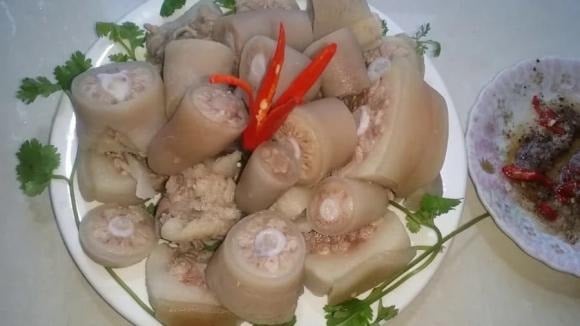Pigs’ tails
In traditional Chinese medicine, pigs’ tails are believed to have a sweet and slightly salty taste, with cooling properties. They are thought to offer a range of health benefits, including:
Energy and Vitality: Pigs’ tails are said to nourish the body, aiding in treating kidney deficiencies, impotence, and premature ejaculation. They are believed to increase overall energy and enhance sexual health.
Joint and Bone Support: The tails are commonly used to address joint and bone issues, such as joint pain, inflammation, and arthritis.

Pigs’ tails are believed to offer a range of health benefits in traditional Chinese medicine.
Skin Care: The collagen in pigs’ tails helps maintain skin moisture and elasticity, combating signs of aging. It is used in some skincare products to reduce wrinkles, soften, and moisturize the skin.
Nutritionist Nguyen Dac Danh highlights the nutritional content of pigs’ tails. In a 100g serving, there is: 17.7g of protein, 33.5g of fat, 1.12mg of vitamin B3, 0.07mg of vitamin B1, 0.07mg of vitamin B2, 14mg of calcium, 47mg of phosphorus, 25mg of sodium, 157mg of potassium, and no carbohydrates.
Notably, pigs’ tails are an excellent source of zinc, containing 1.64mg per 100g, which is approximately 15% of the daily value (based on a 2000-calorie diet).
Zinc is an essential trace element that plays a crucial role in various bodily functions. It contributes to the production of internal control hormones that regulate bodily development and maintain serum testosterone levels. Testosterone is a significant hormone for men, influencing physical appearance and sexual development.
Zinc is vital for immune function and male reproductive health. Research shows that it improves sperm quality and quantity. A deficiency in zinc can impact sperm motility and morphology, increasing the risk of infertility.
Zinc is also essential for prostate health. A lack of zinc can lead to prostate enlargement and other changes in this critical reproductive organ, potentially resulting in infertility.
“In addition to its benefits for male health, pigs’ tails are rich in protein, mainly from the skin, which contains collagen, elastin, and other substances. These compounds help maintain cell structure, moisture, and elasticity, fighting signs of aging. They also protect the skin from harmful environmental factors,” says Danh.
Other Nutritional Benefits
Pigs’ tails are also a source of calcium, phosphorus, iron, and magnesium, all of which play vital roles in building and maintaining strong bones and joints, preventing osteoporosis, and reducing the risk of anemia.
Calcium, as Danh explains, is crucial for bone and tooth health, contributing to their hardness and structure. It is also essential for bone regeneration and recovery from injuries.
Crescent Bones
The crescent bone, or “xương lưỡi liềm” in Vietnamese, is located at the junction of the pig’s front legs, resembling a crescent moon. This part of the pig is composed of cartilage, making it脆 and ideal for making soup or broth. It is a nutritious and delicious addition to any meal.
While some sellers may keep this valuable cut for their family’s bone broth or soup, it is a lesser-known delicacy for most buyers. Beyond its flavor, the crescent bone is an excellent source of collagen, protein, and vitamins. Consuming this bone regularly can promote bone growth, prevent osteoporosis, and boost the immune system.

The crescent bone is a valuable cut often kept by sellers for their families’ bone broth or soup.
Calcium-Rich: The crescent bone is particularly high in calcium, making it ideal for growing children and elderly individuals at risk of osteoporosis. Pregnant women can also benefit from consuming this bone to ensure adequate calcium intake during pregnancy.
Nutritional Value: The meat on the crescent bone is rich in protein and contains a variety of water-soluble extracts, including proteins, providing the body with abundant and high-quality nutrition. Additionally, the crescent bone boasts a high nutritional value.
Unlock Benefits of Meowington’s Meow-tastic Feline Elixir for an Exciting Feverish High
Vietnamese people’s fondness for mangoes is well-known, and they are more than just delicious tropical fruit. Not only do mangoes boast a sweet and sour taste that make them popular for both snacking and cooking, but they also offer a host of health benefits to those who consume them. Originating from Africa, mangoes are now widely grown in both Asia and Latin America.



































